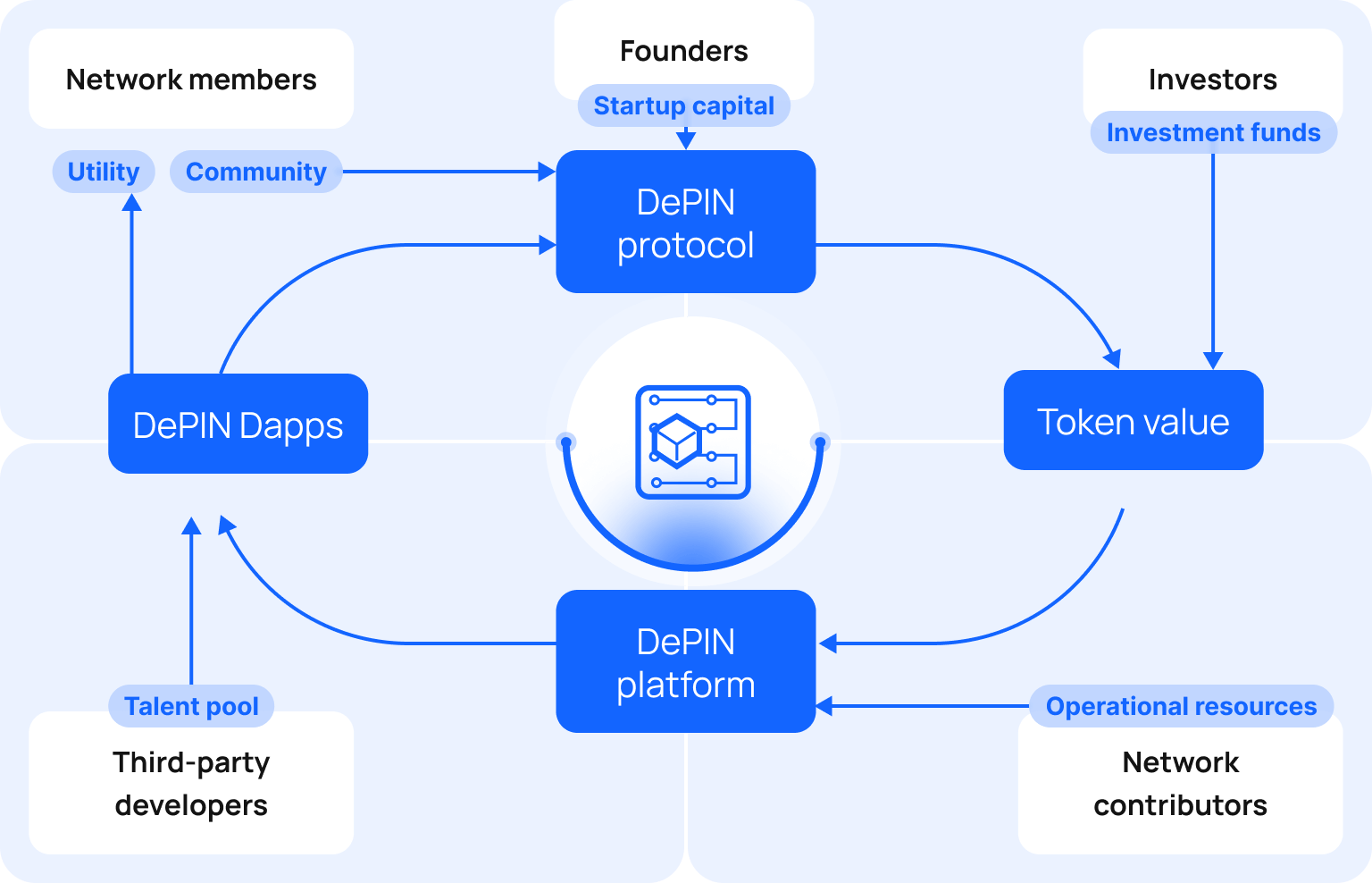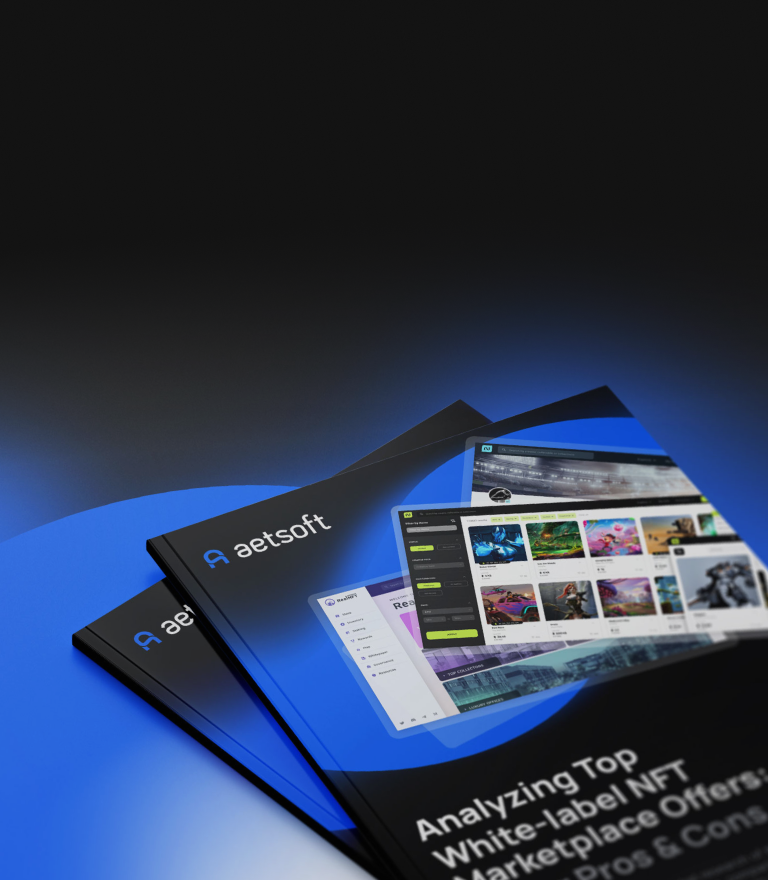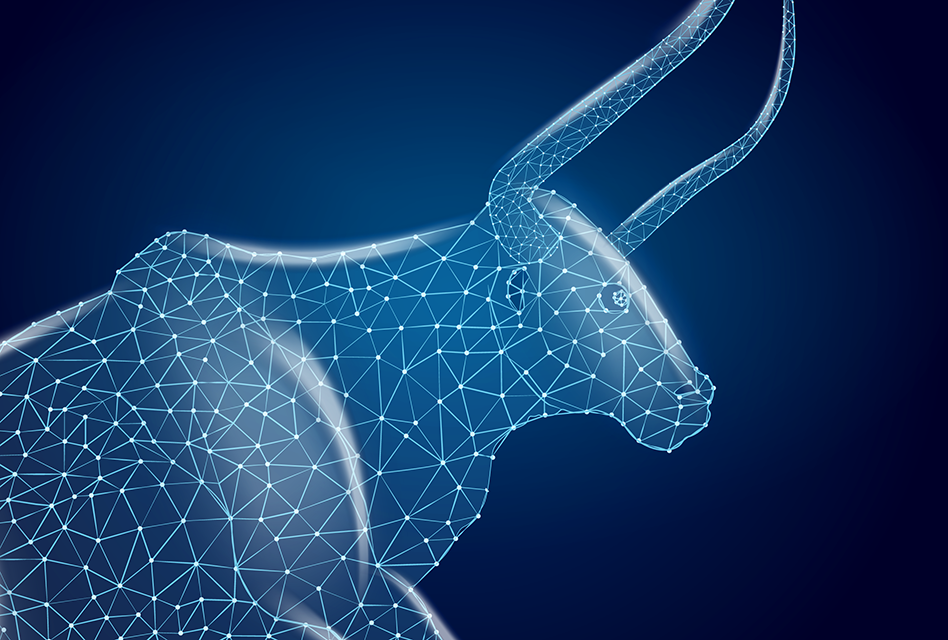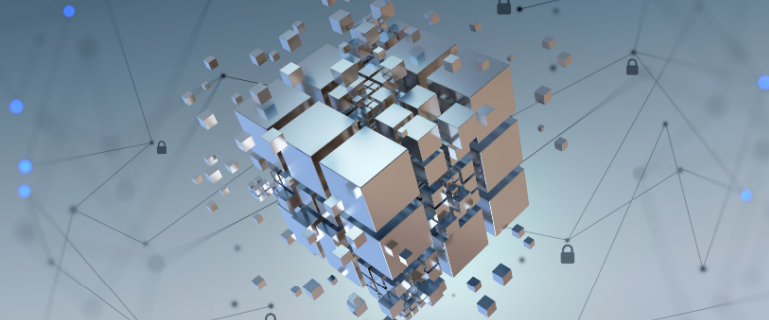What if building essential infrastructure wasn’t controlled by corporations or governments but by the people who use it? That’s exactly what Decentralized Physical Infrastructure Networks (DePIN) are making possible. Through the use of blockchain technology, decentralized crypto payments, and community-led innovations, DePIN is changing the paradigm.
To get the main idea of what is DePIN in crypto, look at Helium as a prime example — a decentralized wireless network where individual contributors deploy hotspots, earn monetization rewards — DePIN tokens — and build coverage globally without relying on telecom providers. As DePIN matures and gains adoption in 2024 and beyond, the effects on energy, mobility, and cloud computing will come into sharper focus.
Key takeaways
- DePIN in crypto refers to Decentralized Physical Infrastructure Networks, where blockchain technology powers the creation and management of infrastructure through community participation.
- DePIN crypto allows community-driven development and infrastructure operation using blockchain technology and crypto incentives.
- With its decentralized model, DePIN reduces costs, scales effortlessly, promotes transparency, and gives global access to users, shifting power away from centralized entities.
- DePIN blockchain impacts diverse sectors like computing, wireless networks, energy, logistics, and identity.
- Despite its promise, DePIN crypto encounters challenges like fragmented liquidity, security concerns, varying regulations, and inefficient governance.
- DePIN projects, such as Helium, DAWN, and Dimo, showcase DePIN’s ability to enhance connectivity, energy accessibility, and control over personal data.
- DePIN’s future includes advancements in sustainability, AI integration, cross-chain interoperability, and AR/VR apps.
What is DePIN in Crypto?
DePIN in crypto refers to a decentralized network model where critical infrastructure is built, owned, and operated through community participation and incentivized with DePIN tokens as rewards.
Unlike traditional centralized models, DePIN allows individuals and organizations to contribute resources like bandwidth, storage, and compute power directly to the network, earning crypto in return. This approach fosters a more democratic and scalable way of building infrastructure while promoting global accessibility and resilience.
How DePIN in Crypto Works: DePIN Flywheel Explained
DePIN lets individuals or communities collaboratively create, own, and sustain physical infrastructure without the need for central institutions.

The flywheel concept is deeply tied to the mechanics of DePIN crypto because it illustrates how community participation and incentives drive continuous growth and sustainability within the network. Here’s how the flywheel works specifically within the DePIN context.
Infrastructure Deployment
The founders kickstart the DePIN flywheel by designing the protocols and structure for the network. This includes incentivizing participants to deploy and maintain physical infrastructure, like wireless hotspots, solar panels, or energy-efficient devices, depending on the specific DePIN project.
For instance, in a decentralized wireless network like Helium, users deploy hotspots to provide internet coverage. Though individual contributions may be small, collectively, they create a decentralized infrastructure where no single company or government entity controls the network. This infrastructure lays the foundation for the entire ecosystem.
Smart contracts are used to define rules for the deployment, maintenance, and rewards distribution within decentralized infrastructure networks.
Incentives
To encourage participation, miners/deployers are rewarded with crypto tokens for their contributions to the network. These incentives serve two purposes:
1. Compensation
Users earn crypto as a direct reward for deploying and maintaining infrastructure.
2. Motivation
The tokens act as an ongoing and scalable incentive, encouraging users to sustain their infrastructure and engage more actively in the network.
As the network expands and increases in value, the rewards can increase, further motivating participants to contribute.
Network Expansion
The DePIN network grows as more participants join and deploy infrastructure, making the network more robust and valuable. For example, when more users deploy wireless hotspots in the Helium network, the coverage area expands, attracting more participants. Growth at this scale doesn’t just help individuals — it builds a more dynamic and widely accessible ecosystem.
Continuous Growth (Flywheel Effect)
As more miners/deployers and third-party developers join, they attract additional end users, further strengthening the network. The decentralized nature of DePIN means the network becomes more resilient and adaptable over time, reinforcing the flywheel effect without relying on a central authority. This positive feedback loop works as follows:
- The more infrastructure deployed, the more users can join the network and participate.
- As the network grows, it offers better rewards, attracting even more participants.
- The network’s expansion increases its value for everyone, reinforcing the cycle and encouraging continuous growth.
The network is self-propelling since its development stems from the active contribution of its users. It is, as such, self-sustaining because it is not owned by one person or organization. As long as there are those willing to participate, the users will further develop and grow the network.
Benefits of DePIN
DePIN in crypto does indeed offer a far more secure, affordable, and scalable way to deal with physical resources like energy grids, internet connectivity, and storage. Due to decentralized control, this opens up wholly new possibilities for individuals and organizations to take part in building and maintaining such systems.
This will not only reduce costs and enhance resilience but also allow more flexibility and quick adaptation to emerging needs. Besides, it may create revenue streams for participants and thus be beneficial for both contributors and the community at large. How? Find the key details in the table.
| BENEFIT | DESCRIPTION | RESULTS |
| Decentralized ownership | Shifted control from centralized entities to community-driven networks that allows users to own and govern infrastructure collectively | Greater autonomy, fairer revenue distribution, and reduced reliance on centralized entities |
| Cost efficiency | Reduced infrastructure expenses thanks to removed intermediaries, optimized resource utilization, and leveraged token-based incentives | Lower costs, optimized resource allocation, and more competitive pricing |
| Scalability and flexibility | Dynamic and modular infrastructure scaling without reliance on centralized entities that makes networks more adaptive to demand | Continuous ecosystem expansion and increased engagement from participants |
| High transparency | End-to-end transparency through blockchain validation | Lower fraud risk, and tamper-proof transactions. |
| Global accessibility | Anyone to participate in infrastructure deployment and access services worldwide | Wider adoption, increased participation |
| Sustainability | Promotion of environmentally friendly practices, such as green energy trading or decentralized renewable energy production by DePIN networks | Reduced carbon footprint, incentivized green practices, and fostered circular economy |
Key Sectors of DePIN
DePIN crypto spans multiple sectors, with each contributing to the growth of the overall infrastructure ecosystem. Here’s a quick look at six core DePIN categories.
Compute
The compute sector is building decentralized cloud networks that enable users to share their computing power for tasks like running apps, processing data, and training AI models. Instead of depending on traditional data centers, DePIN allows most people to get involved in performing distributed workloads. Likewise, within DePIN, AI-enabled computing platforms provide for the joint training of AI models with users vending their processing capacity to perform expensive operations such as machine learning. Decentralized storage systems as a service (like Filecoin) and AI processing platforms based on distributed GPUs are examples of DePIN in compute.
- The ability to scale computing power on demand.
- More people can access powerful computing resources, even in areas lacking traditional infrastructure.
- Distributed AI model training, with users contributing processing capacity.
Wireless
The wireless sector uses decentralized networks to provide internet connectivity and telecom services. DePIN wireless networks offer better privacy and security by removing central control over user data. The sector is expanding into rural areas, offering the potential to create global wireless networks that are both more robust and more equitable.
Community-driven initiatives like Hive allow individuals to deploy wireless hotspots in exchange for crypto rewards, improving network coverage in underserved areas.
- Better coverage in underserved areas and rural regions.
- Community-driven models reduce the cost of deploying wireless networks.
- More equitable access to internet connectivity worldwide.
Sensors
In DePIN, IoT (Internet of Things) devices are deployed decentralized to let individuals and communities contribute their sensors to build networks that help optimize urban and industrial environments.
Examples of sensor-based DePIN systems include smart water meters, environmental monitoring systems, and industrial IoT platforms that collect data from factories and warehouses.
- Decentralized sensors optimize city services like traffic control, waste management, and water usage.
- Industrial IoT sensors in factories enable better equipment monitoring.
- Distributed sensors can track air quality, water pollution, and environmental conditions.
Identity
DePIN-based identity solutions permit self-sovereign identity management, where individuals can verify themselves while still controlling their data. These solutions use blockchain to verify credentials, such as academic degrees, employment history, and personal identity, in a secure and verifiable way.
Examples include decentralized identity (DID) systems and self-sovereign identity solutions (SSI), where users can selectively share their personal information with trusted parties without relying on centralized entities to store sensitive data.
- Blockchain guarantees the authenticity of credentials without the need for centralized verification bodies.
- Users can share selective parts of their identity on a need-to-know basis, keeping sensitive details private.
- Individuals control their personal information, choosing what data to share and with whom.
Energy
For the energy sector, DePIN enables decentralized energy grids where individuals can generate, store, and share renewable energy with others. These networks are often built on blockchain to manage transactions, track energy production, and optimize distribution. One of the main goals of DePIN in energy is to democratize energy generation, particularly renewable energy sources like solar and wind.
- Decentralized grids can dynamically adjust energy supply to match demand.
- Households and businesses can reduce their dependence on central power utilities.
- DePIN promotes the adoption of renewable energy sources, reducing dependency on non-renewable power.
Logistics
In logistics, DePIN has the potential to make supply chains more reliable and secure through blockchain technology. This implies real-time tracking of products from the point of origin to delivery and improving visibility into supply chain operations and auditing.
For example, a company could implement a decentralized system to monitor every step of a product’s journey, from the moment it leaves the manufacturer to when it reaches the customer. By doing so, the company ensures the product is genuine and the process is faster, thanks to real-time tracking and automation.
- With decentralized logistics, every product’s journey can be authenticated.
- Blockchain facilitates quicker verification processes.
- Blockchain enables transparent, real-time tracking of goods.
Key Players and Ecosystems
Pioneering DePIN projects and ecosystems in the DePIN space are driving its evolution, expanding its potential, and laying the foundation for a more open and decentralized future. Let’s see what we mean here.
Decentralized Infrastructure Providers
These players offer the hardware and networks that support DePIN applications. Examples include companies like Helium and Filecoin, which provide decentralized networks for wireless coverage and data storage, respectively.
Blockchain Protocols
DePIN crypto faces strong competition from blockchains like Solana and Base, which have become top choices for DePIN crypto projects. While many DePIN networks build on their own blockchain protocols, Solana and Base attract developers with high scalability, fast transactions, and low costs. Their robust ecosystems — complete with developer tools, partnerships, and community support — further drive growth in the DePIN space.
Governance Platforms
Decentralized autonomous organizations (DAOs) are key in managing and governing DePIN ecosystems. These platforms, such as DAOstack and Aragon, allow for community-driven decision-making, resource allocation, and protocol upgrades.
Hardware Manufacturers
Companies like Nodle and Mithril provide the physical devices that make decentralized networks possible, such as Bluetooth or Wi-Fi hotspots. These devices enable users to participate in the network and earn tokens as rewards for their contribution.
Marketplaces and Exchanges
Platforms like Uniswap and Sushiswap help provide liquidity for DePIN tokens, allowing users to trade the native assets associated with DePIN crypto projects.
DePIN in Crypto Meeting AI

As AI’s influence spreads at a breakneck speed, there is a shift in how investments are allocated within DePIN. Investors and developers are focusing on infrastructure projects that are specifically designed to cater to AI’s high demands for compute, energy, and bandwidth. Some of these shifts include:
Increased funding for AI DePIN platforms
Decentralized compute platforms, such as Bittensor and FoldingCoin, are receiving increased investments as they offer unique opportunities to support AI’s massive processing power requirements. These platforms let individuals and organizations contribute their unused compute resources to AI model training or execution, gaining rewards in return.
AI-specific infrastructure development
DePIN projects are evolving to offer more AI-specific features, such as AI-optimized hardware and software tools. These upgrades are essential to ensure that decentralized infrastructure has the capacity to run advanced AI models and strengthen its ability to perform and manage AI tasks at a greater scale.
Energy-efficient solutions for AI
With AI’s high energy consumption, DePIN investments are increasingly directed toward creating energy-efficient decentralized networks. Projects focused on sustainable energy solutions, such as integrating solar power into decentralized compute networks, are gaining traction.
Increased collaboration between DePIN in crypto and AI startups
AI companies are looking to integrate decentralized compute and storage solutions into their operations, while DePIN projects are looking for ways to serve the growing needs of AI models. Such collaboration is accelerating the development of AI-powered decentralized applications, such as AI-based decision-making systems, that benefit from the scalability, efficiency, and sustainability of DePIN.
Challenges Facing DePIN in Crypto
While it is true that decentralized systems have the potential to drastically change traditional models, it is equally true that there’re challenges that need to be addressed.
| Challenge | DESCRIPTION | Solution |
| Liquidity fragmentation | Difficult for participants to efficiently move capital, manage resources, and access liquidity in real-time due to assets are dispersed across multiple platforms and tokens | Leveraging cross-chain solutions to improve liquidity and simplify resource movement between platforms |
| Sybil attacks | The creation of multiple fake identities or nodes to gain undue control over the network, compromising its integrity, trust, and security | Implementing cryptographic protocols, multi-signature authentication, decentralized identity management, and conducting regular security audits |
| Inconsistent regulations | Uncertainty regarding compliance with data privacy, financial, and infrastructure laws | Adopting a compliance-first approach, working with legal experts, and establishing self-regulatory bodies |
| Governance and decentralized decision-making | Inefficiencies, slow decision-making, and lack of accountability in project development | Implementing hybrid governance models, clear voting mechanisms, and incentivize active participation |
Despite these challenges, ongoing research, innovation, and collaboration within the DePIN space could help to overcome these obstacles, paving the way for a more secure, sustainable, and high-performing decentralized network.
Prominent DePIN Projects: Real-world cases
Here are some notable DePIN projects making waves in the real world and showcasing the power of decentralized models across various industries.
Helium Mobile: A New Kind of Phone Network
Let’s say you’re in a small town far from the nearest telecom tower. Yet, your phone connects to the internet seamlessly. How? People just like you have set up Helium hotspots all around the world, creating a massive, decentralized network. As you walk around, your phone connects to these community-powered hotspots, and in return, you earn Helium tokens.
DAWN: Making Energy and Internet More Accessible
Picture a remote village with no access to the grid. Traditional power companies won’t build infrastructure there because it’s not cost-effective. Thanks to DAWN, the village can generate, trade, and share solar energy with others through its decentralized platform. And it doesn’t stop with energy — DAWN also provides internet access. People in the village can connect to a decentralized network, trading bandwidth with neighbors and other users.
Dimo: A New Way of Thinking About Car Ownership
What if your car could help you earn money? With Dimo, it can. While driving your car as usual, but with Dimo, every time you take a trip, it generates valuable data — about your driving habits, your car’s performance, and even road conditions. Instead of this data being locked away by big car manufacturers, Dimo lets you own it. You can choose to share it with service providers, insurers, or manufacturers, earning rewards in return.
Blackbird Network: Restaurants Rewarding Loyal Customers
Thanks to Blackbird Network, restaurants are sharing a decentralized loyalty program where your rewards don’t expire, and you can redeem them wherever you go. During business lunches or while picking up your coffee, your points could come in handy, and restaurants gain better intelligence on the kind of meals you prefer, which helps them offer you better promotions and improve your experience.
The Future of DePIN in Crypto
DePIN’s future relies on new technologies shaping its impact on digital and physical infrastructure. With the rise of decentralized networks, these innovations will lead to broader adoption, improved performance, and greater functionality across industries.
Expansion of Sensor Networks
As sensor networks expand, DePIN in crypto can apply these systems to collect real-time data in AI, robotics, and environmental monitoring. Such data will help create decentralized systems that can predict weather changes and air pollution levels and even trigger automatic maintenance when needed.
Convergence of AI, Compute, and Decentralized Infrastructure
DePIN in crypto offers a peer-to-peer infrastructure that distributes computing power across a decentralized network of independent nodes, removing centralized control and making the system more open and accessible. Mid-sized companies and freelance researchers can access cheaper, censorship-free AI infrastructure without the intellectual property control typical of centralized computing systems.
Sustainable and Energy-Efficient Networks
Decentralized energy grids powered by renewable sources, tokenized carbon credits, and blockchain-based energy trading platforms will contribute to greener infrastructure. Projects focused on the distribution of power in a decentralized manner can lessen the dependence on centralized grids and offer more affordable energy access. In addition, these networks can manage the energy usage associated with AI processing to diminish the carbon emissions related to high-performance energy computing.
Stronger Cross-Chain Interoperability
Services like LayerZero, Wormhole, and similar interoperability solutions will allow DePIN projects to function across several chains. With greater cross-chain interoperability, DePIN will become a more agile and user-friendly ecosystem, appealing to several users from different blockchain communities and sectors of the economy.
Integration with AR/VR and Spatial Computing
With peer-to-peer networks powering AR/VR applications, DePIN would reduce reliance on centralized cloud services, enabling more accessible and scalable content. Crowdsourced spatial data could enhance virtual environments instantly, improving accuracy and personalization.
Wrapping up
DePIN in crypto is shaking up how we build and manage the physical infrastructure we rely on daily. Instead of leaving it all to big companies, it lets everyone pitch in to create and maintain energy systems, storage, or internet access.
What’s the outcome? A more secure, cost-effective, and scalable way to power the world around us, with more control in the hands of the community. It opens the door to new ways to earn from contributing to the infrastructure that supports everyone. Think of it as infrastructure for the people, by the people.
Aetsoft handles every aspect of building and scaling DePIN networks, focusing on protocol development, Layer 1 protocol creation, and custom consensus mechanics design. We deliver the essential technology to start and grow decentralized infrastructure networks. Contact us for details and take the next step.
F&Q About DePin in Crypto
1. What does DePIN mean?
DePIN stands for Decentralized Physical Infrastructure Networks. It refers to blockchain-powered networks that coordinate real-world infrastructure such as computing power, wireless networks, energy grids, and sensor networks in a decentralized manner. Instead of relying on centralized corporations, DePIN enables individuals and businesses to contribute resources and be rewarded with DEPIN tokens.
2. What is an example of DePIN in crypto?
A prime example of DePIN meaning in action is Helium, a decentralized wireless network. It allows users to set up and maintain wireless hotspots that provide IoT and 5G connectivity in exchange for HNT tokens. This model incentivizes individuals to contribute to building a global, decentralized telecom network rather than relying on traditional telecom providers.
3. What is the difference between blockchain and DePIN?
DePIN is a specific use case of blockchain and Web3 technologies, focusing on decentralized infrastructure. It applies blockchain principles to manage and incentivize real-world decentralized infrastructure networks, such as decentralized computing, storage, and telecommunications.
4. What is the difference between DeFi and DePIN?
DeFi (Decentralized Finance) and DePIN both use blockchain, but they serve different purposes. DeFi replaces traditional financial intermediaries with decentralized protocols. DePIN decentralizes infrastructure networks and incentivizes participants to contribute resources like storage, bandwidth, or computing power.
5. Why is DePIN important?
The importance of DePIN comes from its capability to decentralize the management of physical infrastructure, which improves security, resilience, and efficiency. Using blockchain to reward participation, DePIN makes various areas such as energy, transport, and connectivity more accessible, affordable, and innovative.
6. What are the DePIN coins?
DePIN coins are cryptocurrencies used to incentivize and reward participants in decentralized physical infrastructure networks. These tokens facilitate the operation of various DePIN crypto projects, such as powering networks, deploying resources, and supporting infrastructure maintenance.







